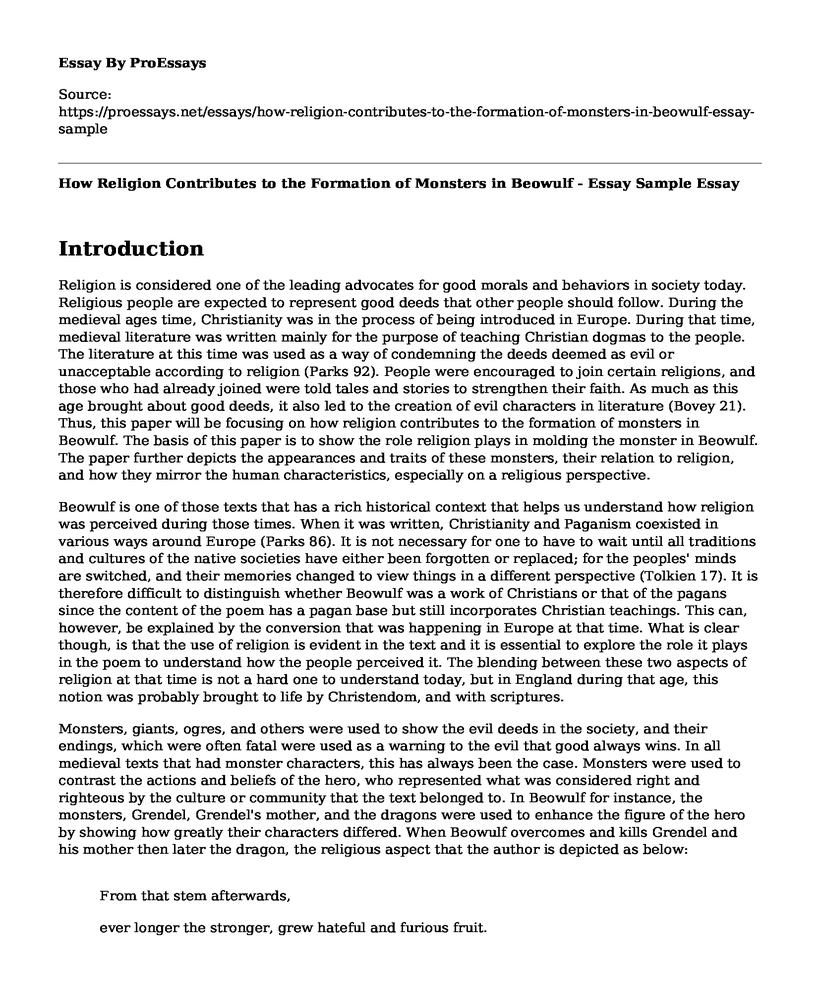Introduction
Religion is considered one of the leading advocates for good morals and behaviors in society today. Religious people are expected to represent good deeds that other people should follow. During the medieval ages time, Christianity was in the process of being introduced in Europe. During that time, medieval literature was written mainly for the purpose of teaching Christian dogmas to the people. The literature at this time was used as a way of condemning the deeds deemed as evil or unacceptable according to religion (Parks 92). People were encouraged to join certain religions, and those who had already joined were told tales and stories to strengthen their faith. As much as this age brought about good deeds, it also led to the creation of evil characters in literature (Bovey 21). Thus, this paper will be focusing on how religion contributes to the formation of monsters in Beowulf. The basis of this paper is to show the role religion plays in molding the monster in Beowulf. The paper further depicts the appearances and traits of these monsters, their relation to religion, and how they mirror the human characteristics, especially on a religious perspective.
Beowulf is one of those texts that has a rich historical context that helps us understand how religion was perceived during those times. When it was written, Christianity and Paganism coexisted in various ways around Europe (Parks 86). It is not necessary for one to have to wait until all traditions and cultures of the native societies have either been forgotten or replaced; for the peoples' minds are switched, and their memories changed to view things in a different perspective (Tolkien 17). It is therefore difficult to distinguish whether Beowulf was a work of Christians or that of the pagans since the content of the poem has a pagan base but still incorporates Christian teachings. This can, however, be explained by the conversion that was happening in Europe at that time. What is clear though, is that the use of religion is evident in the text and it is essential to explore the role it plays in the poem to understand how the people perceived it. The blending between these two aspects of religion at that time is not a hard one to understand today, but in England during that age, this notion was probably brought to life by Christendom, and with scriptures.
Monsters, giants, ogres, and others were used to show the evil deeds in the society, and their endings, which were often fatal were used as a warning to the evil that good always wins. In all medieval texts that had monster characters, this has always been the case. Monsters were used to contrast the actions and beliefs of the hero, who represented what was considered right and righteous by the culture or community that the text belonged to. In Beowulf for instance, the monsters, Grendel, Grendel's mother, and the dragons were used to enhance the figure of the hero by showing how greatly their characters differed. When Beowulf overcomes and kills Grendel and his mother then later the dragon, the religious aspect that the author is depicted as below:
From that stem afterwards,
ever longer the stronger, grew hateful and furious fruit.
The shoots of violence spread far and wide
among the tribes of men. The branches of evil,
hard and sharp, pricked the sons of men.
They still do. From that broad blade every injury
began to blossom. Not without cause can we weep
over this story, this slaughter-grim result [wyrd]. (Heany 988b997a)
In Beowulf, Grendel embodies the violent human nature in its most disgusting and hideous state which is used to mirror the evil habits of humanity. The hero, Beowulf, on the contrary, is portrayed as a King who stands for bravery and justice and everything considered good according to Christianity. In the Bible, the book of Genesis tells a story about two brothers, Cain and Abel. The story describes Cain as a jealous man, who later killed his brother because God seemed to like him more. This is the first case of murder and evil in the Bible; hence Cain is portrayed as evil and Abel as good, (hero) (Parks, 1-16).
Works Cited
Bovey, Alixe. Monsters and grotesques in medieval manuscripts. University of Toronto Press, 2002
Heaney, Seamus. Beowulf. Faber & Faber, 2009.
Parks, Ward. "Prey Tell: How Heroes Perceive Monsters in" Beowulf"." The Journal of English and Germanic Philology 92.1 (1993): 1-16.
Strickland, Debra Higgs. Saracens, demons, & Jews: making monsters in medieval art. Princeton University Press, 2003.
Tolkien, John Ronald Reuel. "Beowulf: the Monsters and the Critics." London, 1936.
Cite this page
How Religion Contributes to the Formation of Monsters in Beowulf - Essay Sample. (2022, Dec 08). Retrieved from https://proessays.net/essays/how-religion-contributes-to-the-formation-of-monsters-in-beowulf-essay-sample
If you are the original author of this essay and no longer wish to have it published on the ProEssays website, please click below to request its removal:
- Essay on Poetic Strategies Used by Ed Sheeran in His Three Songs
- Poetry in Romantic Songs Essay
- Case Study of Death and Dying
- Christian Views on the Nature of Human Persons and Theory of Morals Status Essay Example
- A Doll House: A Play of Marriage, Secrets and Forging - Essay Sample
- Essay on Buddhism in Japan: Origins & Impact on Society
- A Pragmatic Philosophical Worldview: Concerned With Truth and Effectively Addressing Problems - Free Report







